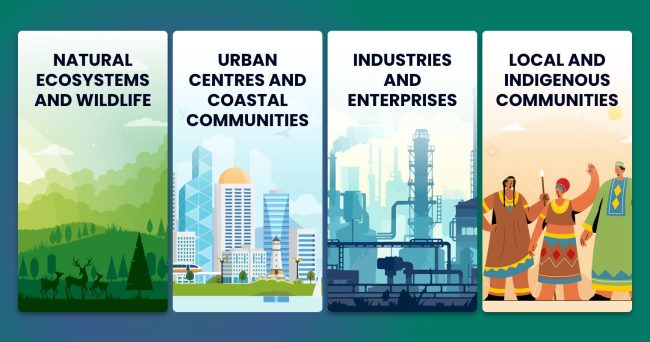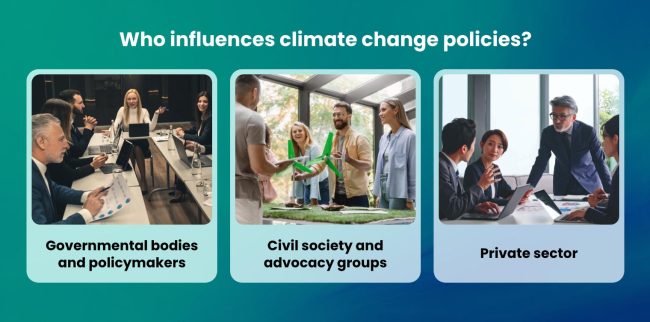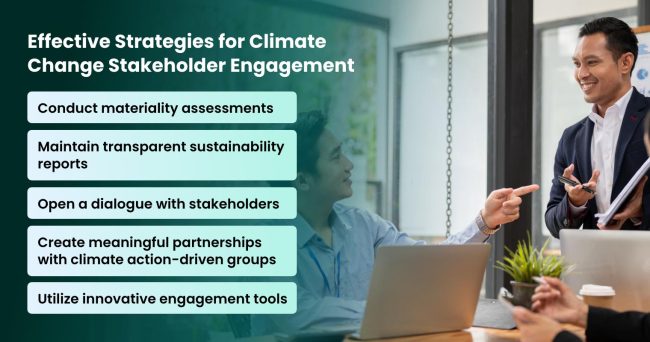Climate change isn’t just an environmental problem. It has become a global issue with far-reaching consequences for economies, societies, and ecosystems.
While some groups bear the brunt of its consequences, others hold the power to drive meaningful change.
But who exactly are these stakeholders, and what role do they play in shaping climate action?
The first step in driving meaningful action is identifying both those most affected and those with the greatest influence to create change. By understanding these key stakeholders, organisations, policymakers, and businesses can take more targeted and effective steps toward sustainability.
This article explores the roles and impact of climate change stakeholders, as well as how ESG considerations are shaping the global response.
Who are the key climate change stakeholders?

A stakeholder is any individual, group, or entity that can be affected by or has an influence on a particular issue. Stakeholders in climate change then include those who experience its environmental consequences firsthand, as well as those with the power to shape policies, business practices, and sustainable solutions.
Because of its global-scale effects, climate change has affected a diverse range of stakeholders. Understanding them is essential in developing effective strategies for mitigation, adaptation, and long-term resilience:
Natural Ecosystems and Wildlife
Natural ecosystems, such as forests and oceans, act as crucial carbon sinks, absorbing significant amounts of greenhouse gases and helping mitigate climate impacts. However, deforestation, pollution, and unsustainable resource extraction have accelerated dramatically. In 2024, global CO₂ emissions had been projected to reach a record 37.4 billion tonnes, pushing atmospheric CO₂ levels to 422 parts per million, well above pre-industrial levels. As a result, these natural safeguards can no longer keep up with the pace of change.
The Amazon rainforest, a vital carbon sink, has experienced significant deforestation. Between August 2023 and July 2024, approximately 6,288 square kilometres of forest were lost. Likewise, marine ecosystems are also under severe threat. It’s estimated that around 14 million tons of plastic enter our oceans each year, with a significant portion accumulating on the seabed. The immense presence of plastic in water systems disrupts vital marine cycles that play an essential role in carbon sequestration.
These disruptions to natural ecosystems are causing irreparable damage to biodiversity, threatening the survival of numerous species, and destabilising entire ecosystems.
Urban Centres and Coastal Communities
Rising sea levels, extreme weather events, and infrastructure damage are becoming increasingly common, and urban areas and coastal communities face significant climate threats.
For instance, coastal cities are experiencing higher-than-ever flooding risks. In cities like New York and Miami, sea levels are expected to rise by as much as 30 cm by 2050. This increases the frequency and intensity of flooding.
Extreme weather events are also intensifying. In 2023, there were almost 400 extreme natural events worldwide. From devastating floods in Libya to heatwaves in Europe, these events are displacing millions, destroying infrastructure, and threatening food and water security.
Farmers, fishermen, and other resource-dependent communities are already feeling the effects of climate change. In 2023, droughts in the Horn of Africa led to the loss of over 13 million livestock, threatening livelihoods. Similarly, overfishing and rising ocean temperatures are forcing fishermen in Southeast Asia, particularly in Indonesia, to navigate increasingly unpredictable and dwindling fish stocks, putting both their economy and food security at risk.
Industries and Enterprises
Sectors like energy, transportation, and manufacturing are all significantly impacted by climate change and major contributors to it.
These industries are highly vulnerable to the direct consequences of extreme weather events, such as rising temperatures, floods, and severe storms. For example, in 2021, wildfires in California disrupted power grids and caused widespread blackouts, affecting energy production. Similarly, transportation networks, such as roads and railways, can be severely impacted by flooding. This was seen in the UK in 2020, when extreme rainfall caused extensive damage to infrastructure, halting freight movement and delaying travel.
At the same time, these same sectors are significant contributors to climate change. The energy sector is the largest emitter of greenhouse gases globally, primarily due to the burning of fossil fuels.
The transportation sector is responsible for around 20% of global carbon emissions, while manufacturing industries such as cement and steel production contribute substantially to global emissions. For example, fossil fuel consumption for energy production and the use of diesel trucks for transportation result in the release of millions of tons of CO2 annually. This constant emission of greenhouse gases creates a feedback loop where industries contribute to the worsening effects of the very challenges they face.
Local and Indigenous Communities
Local and indigenous communities are often on the front lines of climate change. They experience firsthand the effects of environmental degradation, deforestation, and resource scarcity. Drawing from their experiences, along with their traditional knowledge and sustainable practices, they provide crucial insights into climate adaptation strategies.
Businesses and policymakers should engage with indigenous leaders and local communities to ensure climate policies are inclusive and respect cultural heritage. Supporting community-led conservation initiatives and fair resource management practices can contribute to long-term environmental sustainability.
Who influences climate change policies?

Policies and regulations shape the way businesses respond to climate challenges.
Listed below are key players with a crucial role in setting sustainability standards, influencing corporate behaviour, and driving systemic change.
Governmental bodies and policymakers’ impact on climate policies
Governments set climate policies, regulations, and incentives that directly impact businesses.
Compliance with international agreements such as the Paris Agreement and ESG frameworks like the Task Force on Climate-related Financial Disclosures (TCFD) is becoming a business requirement. Companies that proactively align with regulations avoid penalties while positioning themselves as sustainability leaders.
In Singapore, the Carbon Pricing Act imposes a carbon tax on greenhouse gas emissions from industrial facilities, incentivising companies to reduce their carbon footprint and invest in cleaner technologies. Meanwhile, Hong Kong’s Monetary Authority requires banks to assess climate-related risks and integrate these considerations into their risk management frameworks.
Climate-related policies, such as carbon pricing and renewable energy mandates, are reshaping industries. Businesses must stay informed about regulatory developments, engage in policy discussions, and advocate for climate-friendly legislation that aligns with long-term corporate goals.
Civil society and advocacy groups’ influence on climate action
Non-governmental organisations (NGOs), advocacy groups, and grassroots movements also have a hand in shaping public discourse on climate change. Their influence extends to consumer behaviour, investor sentiment, and regulatory shifts.
Greenpeace, for instance, campaigns globally to influence climate policy by advocating for renewable energy and challenging policies that promote fossil fuel dependency. Through their efforts, they have spurred businesses to adopt more sustainable practices and increased public pressure for stronger climate action.
Private sector’s role in climate policy
Through investment decisions and corporate governance, large corporations and financial institutions play a pivotal role in shaping climate strategies. Many firms are adopting science-based targets, green financing, and sustainable procurement practices to meet climate change stakeholder expectations and regulatory demands.
For instance, Unilever has committed to achieving net-zero emissions by 2039 across its value chain. The company has implemented science-based targets for emissions reduction, invested in sustainable sourcing, and focused on green financing to support its climate goals. Unilever’s commitment reflects a growing trend among major corporations to align their business practices with global climate objectives.
Institutional investors, such as pension funds and asset managers, are increasingly prioritising ESG factors in investment decisions. Companies that fail to integrate climate considerations into their strategies may face financial risks, including divestment and declining shareholder confidence.
What is the role of businesses in climate action?
Businesses play a crucial role in addressing climate change.
Beyond reducing their own environmental impact by adjusting operational models, they also influence a broad network of stakeholders. Their responsibilities extend to employees, customers, investors, suppliers, regulators, communities, and the environment itself.
Companies must comply with regulatory policies on climate change to align with global sustainability goals. In addition, businesses need to develop comprehensive ESG strategies that integrate seamlessly with their overall business strategy, ensuring that sustainability is a key driver in decision-making.
Internally, companies must implement policies that promote climate action, such as waste management systems, transitioning to renewable energy sources, and improving energy efficiency. These measures help reduce a company’s carbon footprint while contributing to broader climate goals.
Furthermore, transparency is key. Companies have a responsibility to communicate their climate-related efforts clearly to all stakeholders. This includes publishing accurate and detailed sustainability reports that outline progress, challenges, and the steps being taken to meet environmental goals.
By embedding sustainability into their core operations and stakeholder relationships, businesses can play a leading role in the transition to a low-carbon economy.
Why do businesses need to engage climate change stakeholders?
Stakeholder engagement is a critical component of corporate climate strategy. Businesses that actively involve key players can strengthen their sustainability efforts while driving long-term value.
By engaging stakeholders in environmental issues, organisations can:
Ensure regulatory compliance and avoid legal risks
With evolving climate regulations and ESG reporting requirements, companies that maintain open communication with their stakeholders can stay ahead of compliance obligations.
Enhance brand reputation and customer loyalty
Consumers and clients are increasingly favouring businesses with strong sustainability commitments. Transparent engagement with stakeholders builds credibility and fosters trust.
Access sustainable financing and investment opportunities
Investors are prioritising ESG-aligned businesses. Companies that engage stakeholders effectively can better communicate their climate strategies.
Drive innovation and operational efficiencies
Collaboration with suppliers, employees, and industry partners can lead to innovative solutions that reduce emissions, optimise resource use, and enhance overall efficiency.
Improve risk management and climate resilience
Engaging stakeholders, including local communities and climate experts, enables businesses to anticipate environmental risks and develop robust resilience strategies to mitigate potential disruptions.
Effective Strategies for Climate Change Stakeholder Engagement

Engaging stakeholders in climate action requires more than occasional updates. It demands a structured approach built on communication, collaboration, and long-term commitment.
Meaningful engagement starts with companies implementing initiatives encouraging transparency, inclusivity, and active participation.
Here are key methods to enhance climate change stakeholder engagement:
Conduct materiality assessments
Understanding which climate-related issues matter most to stakeholders is essential for prioritising sustainability initiatives. Conducting materiality assessments helps businesses align their ESG strategies with stakeholder expectations, ensuring resources are directed toward areas with the greatest impact.
Maintain transparent sustainability reports
Transparent disclosure of climate risks, mitigation efforts, and sustainability goals builds trust among stakeholders. By following global ESG frameworks such as GRI, TCFD, or SASB and local regulatory standards, such as SGX, HKEX, SEC, and Bursa Malaysia, companies can communicate their progress effectively and demonstrate accountability.
Open a dialogue with stakeholders
Regular engagement through forums, surveys, roundtables, and one-on-one meetings allows companies to gather insights, address concerns, and strengthen relationships. Open communication fosters trust and ensures that stakeholder perspectives are incorporated into decision-making.
Create meaningful partnerships with climate action-driven groups
Working with NGOs, academic institutions, industry groups, and government agencies enhances credibility and amplifies impact. Collaborative initiatives can drive innovation, facilitate knowledge sharing, and accelerate climate solutions.
Utilise innovative engagement tools
Leveraging technology can enhance stakeholder participation and streamline communication. AI-driven analytics help analyse stakeholder sentiment, while digital engagement platforms, such as interactive dashboards and virtual town halls, facilitate real-time feedback and streamline sustainability reporting.
Driving Climate Action Through Accurate Reporting

Climate change affects every sector, from ecosystems and industries to policymakers and individuals. Businesses that actively engage stakeholders can mitigate risks, seize opportunities, and drive meaningful progress toward sustainability.
Convene ESG can help organisations achieve their sustainability commitments by measuring and tracking carbon emissions, which ensures accountability in implementing their climate strategies. The ESG software streamlines ESG reporting by simplifying data collection, improving collaboration, enhancing data governance, and ensuring compliance with mandatory standards.
With features like automated workflows, dashboards for performance tracking, expert recommendations, and an integrated carbon calculator, businesses can accurately calculate Scope 1, 2, and 3 emissions to support their net-zero goals. From reporting to stakeholder engagement, Convene ESG empowers organisations to assess, refine, and enhance their ESG efforts for real-world climate impact.
Book a demo with Convene ESG to see what this ESG reporting software can do for your commitment to sustainability. Streamline your ESG reporting and take control of your organisation’s role in climate action today.
Beatrice Asuncion has spent the past decade in the digital marketing world, helping brands sound like real people. As a seasoned copywriter and content writer, she’s guided everyone from local pastry shops to international tech companies in finding their voice—and occasionally, their sense of humor. Lately, her work with Convene ESG reflects her commitment to helping organizations communicate their environmental, social, and governance (ESG) initiatives, showing how these values can be embedded authentically across all messaging.













